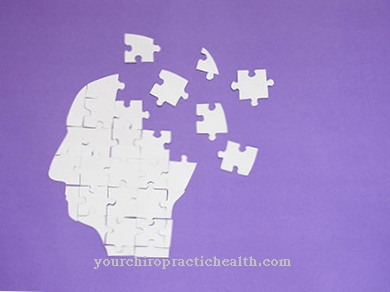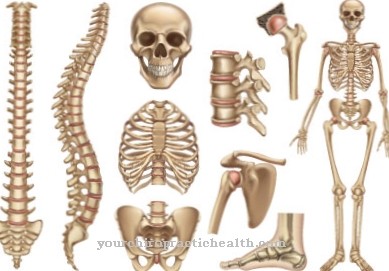A stroke or Stroke is an acute disease of the brain in which a sudden blockage or bleeding in the blood vessels of the brain usually causes a lack of oxygen supply. A stroke is an emergency that requires immediate medical attention.
What is a stroke

A strokerespectively Stroke is a serious malfunction and sudden brain disease. In particular, the oxygen supply to the brain is interrupted. There are two main forms of stroke.
On the one hand, the oxygen supply can be interrupted by insufficient blood flow in the brain (ischemia) and, on the other hand, direct bleeding in the brain (hemorrhagi) can be responsible for a stroke. Due to the lack of oxygen, the brain cannot work normally and nerve cells die within ten to fifteen minutes.
Stroke is more common in the elderly. Most of those affected are over 70 years old. As a result of the consequences of the stroke, most patients are mentally or physically disabled after the stroke. The longer the time after a stroke until acute treatment, the greater the need for care afterwards.
causes
The causes for one stroke are, as already noted, a defective cerebral blood flow (ischemia), which is usually caused by hardening of the arteries (arteriosclerosis) or by an embolism. Above all, the fat deposits that have accumulated in the blood vessels make the vessels narrower, so that less and less blood can flow through them. At some point there will come a point when too little or no blood reaches the brain and therefore no more oxygen can be transported from the lungs to the brain. Risk patients are primarily with diabetes mellitus, high blood pressure and high cholesterol levels.
Another cause of stroke is then the direct bleeding in the brain (hemorrhage), in which there is an embolism or blood clot. The blood clot (thrombus) coagulates in the blood vessels and the blood cannot guarantee the transport of oxygen to the brain.
The last cause is the so-called cerebral haemorrhage (hemorrhagic infarction), which occurs in 1/4 of all strokes. Here, the cerebral hemorrhage occurs when blood vessels in the brain tear or tear. Here too, patients with high blood pressure, diabetes mellitus and high cholesterol levels are particularly affected.
Symptoms, ailments & signs
The symptoms of a stroke are very diverse. Sudden unilateral paralysis or loss of strength for which there is no other cause can indicate a stroke. The paralysis typically occurs in the arm and / or leg. People who have had a stroke may also experience numbness in their arms or legs and face.
Likewise, the corner of the mouth hanging down on one side is always a warning sign. Various visual disturbances can also occur during a stroke. Patients have blurred vision, a reduced field of vision, or double vision. In more severe cases, it can even lead to temporary blindness.
When the language center in the brain is affected by the oxygen deficit, patients speak indistinctly. You keep repeating the same words or syllables and / or taking long pauses while speaking. A complete loss of speech is also possible. In addition to these speech disorders, disorders of the ability to express themselves can also occur.
Those affected can no longer name certain objects or express themselves absolutely meaningless. In addition to these symptoms, sudden changes in balance and dizziness and loss of consciousness can indicate a stroke. Sudden and unbearable headaches are another symptom of a stroke.
Course of disease
The course of the disease Stroke is largely dependent on the severity and damage caused by cerebral haemorrhage and blood clots.
If the stroke is discovered and treated in good time, serious complications can be avoided. It is therefore always advisable to call the emergency doctor in case of suspected risk patients in order to guarantee quick medical help.
Seen in this way, the course of the disease must be assessed individually by the extent of the stroke. The course can range from barely noticeable symptoms to absolute need for care and bed rest.
Above all, the speech disorders and paralysis have a lasting effect on the further life of the person concerned. Most of the brain damage caused by the stroke today is still irreversibly damaged and cannot be cured.
Complications
A stroke can result in serious complications and even death. Most of the time, severe motor impairments and functional disorders of the sensory organs arise as a result of the stroke. Visual problems, hearing loss and balance problems are typical. If the excretory organs are affected, incontinence, urination disorders, intestinal obstruction and other complications can occur.
In most cases, intellectual performance is also reduced - complications from forgetfulness to dementia are possible. As a result of being bedridden, pneumonia, pressure ulcers, urinary tract infections and spasticity can occur. Joint stiffness, muscle wasting and epilepsy can also occur. Finally, a stroke can cause aphasia. In stroke therapy, the drugs used can cause complications.
Blood-thinning drugs rarely cause allergic reactions. Occasionally there is reddening of the skin, itching and burning. Pain relievers and anti-inflammatories are also not free from side effects and interactions.Typical are nausea and vomiting, skin reactions and rarely cardiovascular complaints as well as kidney or liver damage. In the case of an acute stroke, the operation can lead to infection or bleeding. Wound healing disorders and other complications can occur after the procedure.
When should you go to the doctor?
Nowadays the risk of stroke is increasing. Many people get a stroke at a young age. The most important question is when the doctor should be consulted. First of all, it should be noted that the slightest sign of a stroke is already important and should not be ignored. If signs that point to this disease occur more often and limit the affected person in everyday life, a doctor should definitely be consulted.
But it is not always necessary to see a specialist. Often, symptoms that indicate a stroke can also have completely different causes. The first thing to do is to visit the family doctor so that other diagnoses can be ruled out. If he also thinks that a specialist examination is advisable, he will issue a referral. The neurologist is the right person to contact if there are signs of a stroke. He makes sure that certain examinations are arranged in order to make the correct diagnosis. So if symptoms occur frequently that could indicate a stroke, a specialist should be consulted immediately.
Treatment & Therapy
The treatment or therapy of stroke should be initiated as soon as possible. The longer the brain is without oxygen, the more nerve cells die and the brain can no longer be healed. If a stroke occurs, this must be reported to an emergency doctor immediately.
The treatment of a stroke therefore always aims to keep the damage caused by the lack of oxygen as low as possible. However, the therapy depends on the cause of the stroke. This is first determined by the emergency doctor and then in the hospital.
If the cause is a blood clot, drugs are given immediately to dissolve the blockage. The doctor will also try to rule out bleeding in the brain. Today this can be done with the help of computed tomography (CT). In the case of cerebral hemorrhage, neurosurgical intervention usually has to be carried out as soon as possible to stop the bleeding. In addition, possible bruises should be removed. In addition, all vital functions are monitored so that sudden death can be prevented.
The later long-term therapy for a stroke mainly includes the treatment of motor disorders such as speech disorders and paralysis. Above all, the rehabilitation is then in the foreground of the treatment in order to give the person affected a dignified life back as far as possible.
prevention
stroke can be prevented. However, this must be done as early as possible and for a lifetime. This includes, above all, low-fat food, lots of exercise and sport, little stress, no smoking and excessive drinking of alcohol. Too much sweet food should also be avoided. Frequent medical examinations can also provide possible warnings in good time.
Aftercare
Good aftercare after a stroke makes a decisive contribution to regaining physical and mental abilities. Which measures are necessary and useful depends on the severity of the stroke and the impairment it causes. The acute treatment in the hospital should be followed immediately by rehabilitation in a specialist clinic: This can reduce the consequences of the stroke, while at the same time the patient learns to cope with everyday life with unavoidable permanent restrictions.
Physiotherapy is very important, in which the mobility and perception of the impaired side of the body and thus the motor skills are improved. During occupational therapy, everyday activities such as dressing, eating or household chores are practiced. The patient is also trained in the use of aids with which he can cope better with his everyday life.
The aim of speech therapy is to reduce speech, speech and swallowing disorders and thereby restore communication skills and independent food intake as best as possible. Neuropsychological rehabilitation is advisable for memory disorders, attention deficits and for the emotional stabilization of the patient.
After the rehabilitation measure, blood pressure and blood values should be checked regularly by the family doctor and, if necessary, adjusted with medication; in many cases, further outpatient physical, occupational and speech therapy is useful. Effective aftercare also includes eliminating risk factors such as smoking or being overweight.
You can do that yourself
A stroke is a medical crisis in which an emergency doctor must be called in immediately. Those affected should seek medical help at the first signs. Self-help measures are only indicated during convalescence.
A stroke is often accompanied by damage to the brain, which severely limits the person's ability to speak. In this case, patients should learn to speak again as soon as possible with the help of a speech therapist. Perseverance and patience are required here. Without the committed cooperation of the patient, there is hardly any improvement here. Motor skills are often impaired after a stroke. In this case, physiotherapeutic and occupational therapy measures help the patient to improve motor skills again and to be able to do everyday tasks himself.
Often the patients suffer very badly psychologically due to the physical impairment. This is especially true if the previous job has to be given up as a result of the stroke. Patients usually cope better with this psychological trauma if they exchange ideas with other sufferers. There are now numerous self-help groups both on site and on the Internet. In larger cities there are even so-called stroke guides who help those affected to cope with the greatly changed life situation.


.jpg)
.jpg)

.jpg)
.jpg)






.jpg)

.jpg)
.jpg)











.jpg)